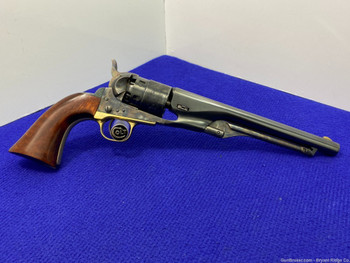Description
Item Description
Bryant Ridge Co. is pleased to present this scarce single-action revolver today for a penny-start auction, this is the Colt 1860 Army Richards Conversion!
SPECIFICATIONS:
Manufacturer: Colt
Model: 1860 Army Richards Conversion
Serial: 4064
Date of Manufacture: 1861 (According to https://www.colt.com/serial-lookup/) / Converted Sometime Between 1869 and 1978
Caliber: .44 Colt Centerfire
Finish: Nickel Plated
Barrel Length: 8"
Optics/Sights: Blade Front with Notch Rear
Stock/Grips: Smooth Walnut
Action: Single-Action
Markings: Standard / The top of the barrel is stamped “ADDRESS COL. SAML COLT NEW-YORK U.S.AMERICA”. The left side of the frame is stamped “PAT.JULY.25.1871 / PAT.JULY.2.1872.”. The cylinder is engraved with a naval scene.
Bryant Ridge's Analysis:
Colt, like every other major U.S. maker, was effectively locked out of manufacturing practical cartridge revolvers by Rollin White’s bored-through cylinder patent, which remained in force under Smith & Wesson until 1869. With that obstacle removed, Colt faced a market already shifting decisively toward metallic cartridges, but the company’s stock in trade was still its large inventory of percussion frames and parts — the 1849 Pocket, 1851 Navy, 1860 Army, and 1862 Police being the mainstays. Those designs, although enormously popular, were increasingly outmoded compared to the speed and convenience of cartridge revolvers. Colt’s long-term answer was the purpose-built Single Action Army of 1873, but in the crucial four-year window between 1869 and 1873, the firm had to put marketable cartridge revolvers into production quickly and cheaply. The earliest experiment was the Thuer conversion (patented in 1868 by F. Alexander Thuer), which tried to circumvent the Rollin White patent by designing a front-loading metallic cartridge.
Model: 1860 Army Richards Conversion
Serial: 4064
Date of Manufacture: 1861 (According to https://www.colt.com/serial-lookup/) / Converted Sometime Between 1869 and 1978
Caliber: .44 Colt Centerfire
Finish: Nickel Plated
Barrel Length: 8"
Optics/Sights: Blade Front with Notch Rear
Stock/Grips: Smooth Walnut
Action: Single-Action
Markings: Standard / The top of the barrel is stamped “ADDRESS COL. SAML COLT NEW-YORK U.S.AMERICA”. The left side of the frame is stamped “PAT.JULY.25.1871 / PAT.JULY.2.1872.”. The cylinder is engraved with a naval scene.
Bryant Ridge's Analysis:
Colt, like every other major U.S. maker, was effectively locked out of manufacturing practical cartridge revolvers by Rollin White’s bored-through cylinder patent, which remained in force under Smith & Wesson until 1869. With that obstacle removed, Colt faced a market already shifting decisively toward metallic cartridges, but the company’s stock in trade was still its large inventory of percussion frames and parts — the 1849 Pocket, 1851 Navy, 1860 Army, and 1862 Police being the mainstays. Those designs, although enormously popular, were increasingly outmoded compared to the speed and convenience of cartridge revolvers. Colt’s long-term answer was the purpose-built Single Action Army of 1873, but in the crucial four-year window between 1869 and 1873, the firm had to put marketable cartridge revolvers into production quickly and cheaply. The earliest experiment was the Thuer conversion (patented in 1868 by F. Alexander Thuer), which tried to circumvent the Rollin White patent by designing a front-loading metallic cartridge.
The system was awkward and commercially unsuccessful, but it showed Colt’s eagerness to find a workable path into the metallic-cartridge market even before the patent formally expired. Once the way was clear, Colt launched a series of factory conversions that adapted existing percussion revolvers to fire cartridges. Collectors and historians often classify these into “Type I” and “Type II” transitional models, which used existing percussion parts with only partial modification, before the more standardized conversions came into production. These transitional types are less common today but represent Colt’s earliest practical metallic-cartridge revolvers. The first broadly adopted system was the Richards conversion (Charles B. Richards, patent of 1871). About 9,000 were produced between roughly 1871 and 1878, mostly on the 1860 Army frame with some smaller-frame examples. Richards’ design added a separate conversion ring (or breechplate) to the rear of the frame that carried a loading gate and a floating firing pin.
The loading lever recess was plugged and smoothed, and a distinctive feature was the rear sight, mounted on the new breechplate rather than on the barrel. The Richards–Mason conversions, beginning in 1872, were refinements and simplifications of this system, credited jointly to Richards and William Mason. These eliminated the separate conversion ring, used a conventional cylinder, redesigned the ejector-rod housing, and were overall more efficient to manufacture and maintain. About 2,100 Richards–Mason 1860 Army conversions were built between 1877 and 1878, and several thousand more were applied to 1851 and 1861 Navy frames, often chambered in .38 caliber.
Between the conversions and the new Single Action Army came yet another transitional product, the Colt 1871–72 Open Top, a purpose-built cartridge revolver that borrowed heavily from percussion frame architecture but was designed from the start for metallic cartridges. Produced in only modest numbers, the Open Top directly informed the design of the 1873 Peacemaker, which became Colt’s definitive entry into the metallic-cartridge era. In short: Colt’s path to the Peacemaker was not a single leap but a series of transitional steps — the experimental Thuer, the Type I/II factory conversions, the Richards and Richards–Mason refinements, and the Open Top — each stage marking a necessary bridge from percussion tradition to cartridge modernity.
Return Policy:
We gladly offer a 3 day unfired inspection policy from the time that the firearm is delivered to your FFL. Refunds are available for all qualifying orders.
Shipping Details
Handgun Standard Shipping with Insurance $50.00
Long Gun Standard Shipping with Insurance $70.00
Any orders placed with magazines that are not compliant with your state, county, or city regulations will not ship with your order.
We strive to ship orders within the close of the following business day after payment and documentation is received.
Payment Details
We accept all forms of Payment including Personal Check, Business Check, PO Money Orders, Certified Check, Etc.
Please note we place a 7 business day hold on shipment, for all non-certified payments.
Payment MUST be received within 14 days.
Return Policy
We gladly offer a 3 day unfired inspection policy from the time that the firearm is delivered to your FFL. Refunds are available for all qualifying orders.
Additional Details
Our #1 priority is customer satisfaction. We want to build a lasting trust in the relationship with our customers, so that you will always look to us for all your firearms needs. If you have any issues with your transactions please contact us, and we will work with you to resolve any issues you may have. We greatly appreciate your trust in us and we look forward to fulfilling all your future firearm needs.
Bryant Ridge also reserves the right to cancel any sales that may occur while gunbroker.com is experiencing technical issues that affects the entire site or a complete site outage, within an hour of the auction ending.
We have an amazing inventory of classic and collector firearms that we are adding to Gunbroker daily. Stay up to date on all of our latest auction by adding us to your favorite sellers list.

























